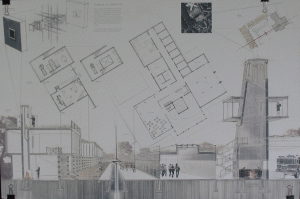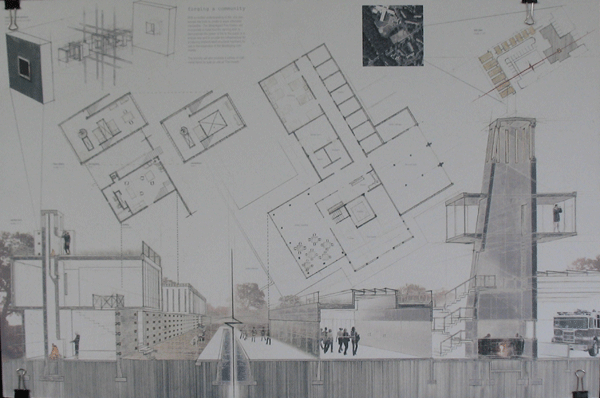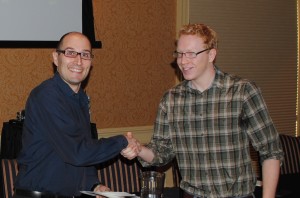
The annual Virginia Society AIA Prize competition was held over the weekend of Feb. 1-4, 2013. This year’s competition has a new partner and Corporate Sponsor, the Virginia Housing Development Authority, who collaborated with faculty from Virginia Tech’s Washington Alexandria Architecture Center to develop the competition program brief. Students in Virginia’s architecture schools were given the program Friday at 5 p.m. The students worked over the weekend to create a board presenting their design solution by 9 a.m. Monday morning.
The 2013 Prize program asked the students to propose a design for a mixed-use fire station combined with dwelling units for the Beauregard neighborhood in Alexandria.
From the program:
“The building should consider the well-being of the community, enhancing a sense of place by designing this mixed use building for dwelling and fire protection. Mixed-use/mixed-income developments are important in the revitalization of older communities, complementing existing communities, traditionally designed in proximity of housing to goods, services, transportation and jobs. Giving new life to older communities such as Beauregard will come about by introducing new dwellings and protections (such as a fire station) to these communities. In this design competition you are asked to consider the powerful qualities of both fire and dwelling as you devise a design that reaches beyond pragmatic and efficient means. Your design should emphasize the power of home and fire while creating a potential for happiness, comfort, and security within this new community.”
Faculty from the schools (Hampton University, Virginia Tech WAAC, Virginia Tech Blacksburg, and the University of Virginia) reviewed all the submitted boards and selected ten finalists from each school to send to the Society. The jury, chaired by Mary Patton Cox, FAIA, met in April to select this year’s winner as well as Best of School boards from each of the remaining schools.
The 2013 Virginia Society AIA Prize Winner is Robert Lingo of Virginia Tech
From the jury:
“We liked the way this entry takes the program from the abstract to the real, all in one board. We liked the use of the foundry, combining a positive use of fire with a firefighting facility. We also liked the varying scales, both macro and micro. This entrant clearly thought beyond the scope of the problem, incorporating a community outreach component, into their solution. The board is also a nicely designed composition. Anyone can understand the presentation techniques.”
Best of School WAAC – Liz M. Fibleuil
From the jury:
“We liked the bold expression of fire, and the bold strokes of the presentation. The entry takes an intangible and gives it three-dimensional expression in the forms and floor plan. The use of color in the board is very vivid, as is the use of text in the descriptions of the design concepts. The concept was conveyed well and well executed; we understood what they were trying to say.”
Best of School Hampton University – Alvin L. Mendoza
From the jury:
“This was a project that truly integrates the sense of community into the complex. Not a traditional fire station per se, but that is partly what makes it remarkable. It’s an iconic structure which is tied into the community and integrates the programmatic elements. We liked the lyrical illustration of licks of flame, which is a creative interpretation.”
Honorable Mention – Kevin Gerrity, Virginia Tech
From the jury:
“We understand that this is not really a practical solution, but we liked the strong conceptual design, especially the components that can be plugged in as needed… very adaptable! The design of the board is lovely, very striking. The imagery is quite alluring, it draws you to it. Even the text box lines up with the residential floor plans. The section and floor plans describe it very well. A strong idea.”
The Virginia Society AIA Prize is sponsored by the Virginia Housing Development Authority.



